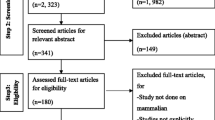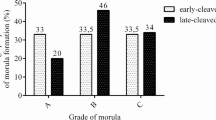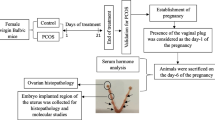Abstract
Prostaglandin E2 (PGE2) has been introduced as an important factor for embryo implantation. So the present study was carried out to evaluate the effect of seminal fluid (SF) on PGE2 pathway in uterus tissues of mice during window of preimplantation. The messenger RNA (mRNA) expressions of microsomal PGE synthase (mPGES) and cytosolic PGE synthase (cPGES) as well as protein expression of PGE receptor 2 and 4 (EP2 and EP4) were determined in uterine tissue of control and seminal vesicle-excised (SVX)-mated female mice during days I to 5 of pregnancy using real-time polymerase chain reaction (qRT-PCR) and Western blotting, respectively. We found that mRNA expression of mPGES at day I and 2 of pregnancy was significantly higher in the control group than the SVX-mated group (P <.05), but such result was not obtained for cPGES expression. The protein levels of EP2 at day I to 4 of pregnancy were significantly higher in the control group compared with the SVX-mated group (P <.05), also the EP4 levels were significantly different between the control and SVX-mated groups at the first day of pregnancy (P <.05). Implantation rate was higher in the control group and also there were positive correlations between mPGES and EP2 expressions in the fifth day of pregnancy with implantation rate. Our results demonstrated significant effect of SF on uterine expressions of the evaluated factors, especially mPGES and EP2. Regarding the correlations between levels of these factors and implantation rate, we suggest that possibly one of the important mechanisms of SF in affecting female pregnancy is through mPGES and EP2.
Similar content being viewed by others
References
Kaczynski P, Kowalewski MP, Waclawik A. Prostaglandin F2a promotes angiogenesis and embryo-maternal interactions during implantation. Reproduction. 2016;151(5):539–552.
Sordelli MS, Beltrame JS, Cella M, et al. Interaction between lysophosphatidic acid, prostaglandins and the endocannabinoid system during the window of implantation in the rat uterus. PLoS One. 2012;7(9):e46059.
Sharkey DJ, Macpherson AM, Tremellen KP, Mottershead DG, Gilchrist RB, Robertson SA. TGF-P mediates proinflammatory seminal fluid signaling in human cervical epithelial cells. J Immunol. 2012;189(2):1024–1035.
Robertson SA, Prins JR, Sharkey DJ, Moldenhauer LM. Seminal fluid and the generation of regulatory T cells for embryo implantation. Am JReprod Immunol. 2013;69(4):315–330.
Poiani A. Complexity of seminal fluid: a review. Behav Ecol Sociobiol. 2006;60(3):289–310.
Sharkey DJ, Tremellen KP, Jasper MJ, Gemzell-Danielsson K, Robertson SA. Seminal fluid induces leukocyte recruitment and cytokine and chemokine mRNA expression in the human cervix after coitus. J Immunol. 2012;188(5):2445–2454.
Robertson S. Seminal fluid signaling in the female reproductive tract: lessons from rodents and pigs. JAnim Sci. 2007;85(suppl 13):E36–E44.
Archbald L, Gronwall R, Pritchard E, Tran T. Acrosome reaction and concentration of prostaglandin E2 in semen of rams treated with flunixin meglumine (Banamine). Theriogenology. 1990; 33(2):373–383.
Marley P, Smith C. Proceedings: the source and a possible function in fertility of seminal prostaglandin-like material, in the mouse. Br J Pharmacol. 1974;52(1):114P.
Joseph T, Zalenskaya IA, Sawyer LC, Chandra N, Doncel GF. Seminal plasma induces prostaglandin-endoperoxide synthase (PTGS) 2 expression in immortalized human vaginal cells: involvement of semen prostaglandin E2 in PTGS2 upregulation. Biol Reprod. 2013;88(1):13.
Salleh N. Diverse roles of prostaglandins in blastocyst implantation. Sci World J. 2014;2014:968141.
Waclawik A. Novel insights into the mechanisms of pregnancy establishment: regulation of prostaglandin synthesis and signaling in the pig. Reproduction. 2011;142(3):389–399.
Deb K, Reese J, Paria BC. Placenta and Trophoblast: Methods and Protocols Volume 1. In: Soares MJ, Hunt JS, eds. Totowa, NJ: Humana Press; 2006;9–34.
Livak KJ, Schmittgen TD. Analysis of relative gene expression data using real-time quantitative PCR and the 2-AACT method. Methods. 2001;25(4):402–408.
Ni H, Sun T, Ma XH, Yang ZM. Expression and regulation of cytosolic prostaglandin E synthase in mouse uterus during the peri-implantation period. Biol Reprod. 2003;68(3):744–750.
Scherle PA, Ma WG, Lim H, Dey SK, Trzaskos JM. Regulation of cyclooxygenase-2 Induction in the mouse uterus during decidua-lization. An event of early pregnancy. J Biol Chem. 2000;275(47):37086–37092.
Tanioka T, Nakatani Y, Semmyo N, Murakami M, Kudo I. Molecular identification of cytosolic prostaglandin E2 synthase that is functionally coupled with cyclooxygenase-1 in immediate prostaglandin E2 biosynthesis. J Biol Chem. 2000;275(42):32775–32782.
Hara S, Kamei D, Sasaki Y, Tanemoto A, Nakatani Y, Murakami M. Prostaglandin E synthases: understanding their pathophysiological roles throughmouse genetic models. Biochimie. 2010;92(6):651–659.
Robertson SA, Seminal plasma and male factor signalling in the female reproductive tract. Cell Tissue Res. 2005;322(1):43–52.
Terzuoli E, Donnini S, Giachetti A, et al. Inhibition of hypoxia inducible factor-la by dihydroxyphenylethanol, a product from olive oil, blocks microsomal prostaglandin-E synthase-1 /vascular endothelial growth factor expression and reduces tumor angiogen-esis. Clin Cancer Res. 2010;16(16):4207–4216.
Ni H, Sun T, Ding NZ, Ma XH, Yang ZM. Differential expression of microsomal prostaglandin E synthase at implantation sites and in decidual cells of mouse uterus. Biol Reprod. 2002;67(1):351–358.
Murakami M, Naraba H, Tanioka T, et al. Regulation of prostaglandin E2 biosynthesis by inducible membrane-associated prostaglandin E2 synthase that acts in concert with cyclooxygenase-2. J Biol Chem. 2000;275(42):32783–32792.
van Rees BP, Sivula A, Thorén S, et al. Expression of microsomal prostaglandin E synthase-1 in intestinal type gastric adenocarcinoma and in gastric cancer cell lines. Int J Cancer. 2003; 107(4):551–556.
Stichtenoth DO, Thorén S, Bian H, Peters-Golden M, Jakobsson PJ, Crofford LJ. Microsomal prostaglandin E synthase is regulated by proinflammatory cytokines and glucocorticoids in primary rheumatoid synovial cells. J Immunol. 2001;167(1):469–474.
Lazarus M, Kubata BK, Eguchi N, Fujitani Y, Urade Y, Hayaishi O. Biochemical characterization of mouse microsomal prostaglandin E synthase-1 and its colocalization with cyclooxygenase-2 in peritoneal macrophages. Arch Biochem Biophys. 2002;397(2):336–341.
Barranco I, Roca J, Ruber M, et al. Cytokines in boar seminal plasma. Reprod Domestic Anim. 2014;49(1):116.
Zeinali M, Hadian Amree A, Khorramdelazad H, Karami H, Abedinzadeh M. Inflammatory and anti-inflammatory cytokines in the seminal plasma of infertile men suffering from varicocele [Published online October 6, 2016]. Andrologia.
Sharkey DJ, Macpherson AM, Tremellen KP, Robertson SA. Seminal plasma differentially regulates inflammatory cytokine gene expression in human cervical and vaginal epithelial cells. Mol Hum Reprod. 2007;13(7):491–501.
Lau I, Saksena S, Chang M. Pregnancy blockade by indometha-cin, an inhibitor of prostaglandin synthesis: its reversal by prostaglandins and progesterone in mice. Prostaglandins. 1973;4(6):795–803.
Tilley SL, Audoly LP, Hicks EH, et al. Reproductive failure and reduced blood pressure in mice lacking the EP2 prostaglandin E 2 receptor. J Clin Invest. 1999;103(11):1539–1545.
Lim H, Dey S. Prostaglandin E2 receptor subtype EP2 gene expression in the mouse uterus coincides with differentiation of the luminal epithelium for implantation 1. Endocrinology. 1997; 138(11):4599–4606.
Pakrasi P, Jain A. Cyclooxygenase-2 derived PGE2 and PGI2 play an important role via EP2 and PPAR8 receptors in early steps of oil induced decidualization in mice. Placenta. 2008; 29(6):523–530.
Waclawik A, Kaczynski P, Jabbour HN. Autocrine and paracrine mechanisms of prostaglandin E2 action on trophoblast/conceptus cells through the prostaglandin E2 receptor (PTGER2) during implantation. Endocrinology. 2013;154(10):3864–3876.
Vilella F, Ramirez L, Berlanga O, et al. PGE2 and PGF2a concentrations in human endometrial fluid as biomarkers for embryonic implantation. J Clin Endocrinol Metab. 2013;98(10):4123–4132.
Sales K, Katz A, Millar R, Jabbour H. Up-regulation of expression of cyclooxygenase (COX)-2 and prostaglandin E receptors (EP2 and EP4) in HeLa cells by seminal plasma. 192nd Meeting of the Society for Endocrinology, London, UK 03 December 2001 - 04 December 2001. Society for Endocrinology. Endoc Abstr. 2001.
Adefuye AO, Sales KJ, Katz AA. Seminal plasma induces the expression of IL-la in normal and neoplastic cervical cells via EP2/EGFR/PI3K/AKT pathway. J Mol Signal. 2014;9:8.
Gidley-Baird A. Plasma progesterone, FSH and LH levels associated with implantation in the mouse. AustJBiol Sci. 1977;30(4):289–296.
Yang Z, Das S, Wang J, Sugimoto Y, Ichikawa A, Dey S. Potential sites of prostaglandin actions in the periimplantation mouse uterus: differential expression and regulation of prostaglandin receptor genes. Biol Reprod. 1997;56(2):368–379.
Bromfield JJ, Schjenken JE, Chin PY, Care AS, Jasper MJ, Robertson SA. Maternal tract factors contribute to paternal seminal fluid impact on metabolic phenotype in offspring. Proc Natl Acad Sci. 2014;111(6):2200–2205.
Modi DN, Bhartiya P. Physiology of embryo-endometrial cross talk. Biomed Res J. 2015;2(1):83–104.
Crawford G, Ray A, Gudi A, Shah A, Homburg R. The role of seminal plasma for improved outcomes during in vitro fertilization treatment: review of the literature and meta-analysis. Hum Reprod Update. 2015;21(2):275–284.
Author information
Authors and Affiliations
Corresponding author
Rights and permissions
About this article
Cite this article
Shahnazi, M., Nouri, M., Mohaddes, G. et al. Prostaglandin E Pathway in Uterine Tissue During Window of Preimplantation in Female Mice Mated With Intact and Seminal Vesicle-Excised Male. Reprod. Sci. 25, 550–558 (2018). https://doi.org/10.1177/1933719117718272
Published:
Issue Date:
DOI: https://doi.org/10.1177/1933719117718272




